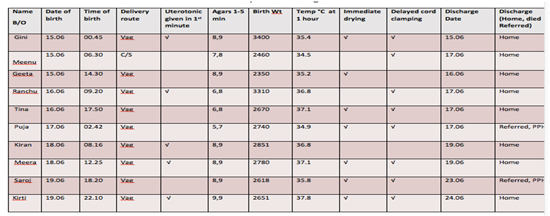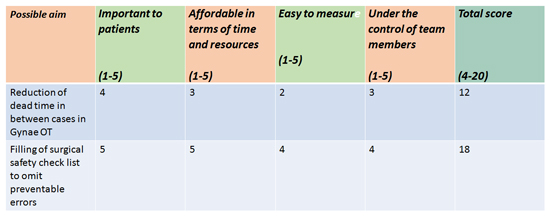Identification of problems in Quality Improvement Step-1
- Introduction...
- 1. Steps in QI...
- 2. Session I...
- 3. How to identify...
- 4. How to review d...
- 5. Make a List of ...
- 6. Choosing a Prob...
- 7. Prioritize the ...
- 8. Planning...
- 9. Select Your Tea...
- 10. Select Your T...
- 11. Why Teamwork i...
- 12. Aim statement...
- 13. Aim statement...
- 14. SMART Aim...
- 15. Aim statement...
- 16. Aim statement ...
- 17. Aim statement...
 |
 |
Introduction
DR. SEEMA SINGHAL
MS, FACS, FICOG, FCLS, MNAMS
Assistant Professor
Department of Obstetrics and Gynaecology
All India Institute of Medical Sciences, New Delhi
1. Steps in QI
Step 1: Identifying a problem, forming a team and writing
an aim statement
Step 2: Analyzing the problem and measuring quality
of care
Step 3: Developing and testing changes
Step 4: Sustaining improvement
2. Session I

► You will learn
♦ How to review data to identify problems
♦ How to prioritize which problems to work on
♦ How to form a team to work on that problem
♦ How to write a clear ‘aim statement’
3. How to identify a Problem


4. How to review data

5. Make a List of what you don’t like

6. Choosing a Problem
► Simple , easy to fix & amenable to change
► Value for patient ( impact )
► Dose not need much resources
► Short turn about time - early results
► Avoid - Long term projects
♦ Mortality as outcome e.g. 12 in a year ,
difficult to document
♦ Hemorhagic disease in newborn
(vitamin K related) – Follow up required
Early success motivates Team
7. Prioritize the Problem

8. Planning

9. Select Your Team

► Are involved-they are already doing the work that needs
change
► Look for volunteers
♦ Are enthusiastic – they want to make changes
♦ Are influential - others people listen to them and
they can get things done
10. Select Your Team Members
► Identify who need to be in Team
♦ at every level
♦ from all department
♦ from administrators to cleaners
♦ pick – Leader ,Recorder ,Communicator

11. Why Teamwork is important for improvement ?
► Healthcare setting = Range of people
► Given the opportunity ,staff can identify problems and
generate ideas to resolve them
► Participation improves ideas , increases buying-in , and
reduces resistance to change
► Accomplishing things together increases the confidence
of each member
12. Aim statement
► Description of a team's desired outcome
► Expressed in a measurable and time-specific way

13. Aim statement
► Characteristics of Good Aim Statement
► States a clear specific aim
► Linked to specific patient population
► Should include a goal
♦ Neither too difficult nor too long to achieve
Includes a solution
♦ Do not include possible, yet unproven solutions
14. SMART Aim

15. Aim statement
► Problem: Central line associated blood stream infections
in Medical ICU
► To reduce the incidence of Central line associated blood
stream infections in Medicine ICU of AIIMS New Delhi
from 30% to 10% in next 6 weeks.
► Who (which patients )- Patients admitted in Medicine
ICU of AIIMS New Delhi
► What (the outcome)-Central line associated blood
stream infections
► How much (the amount of desired improvement )-
from baseline rate of 30% to <10%
► By when (time over which change will occur)- within
6 weeks
16. Aim statement Choose most appropriate


17. Aim statement

